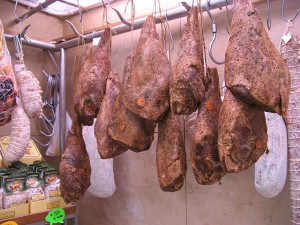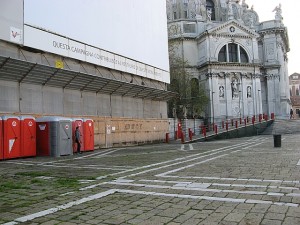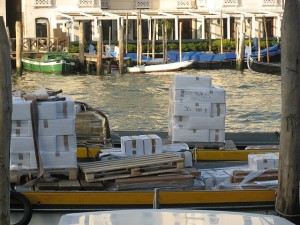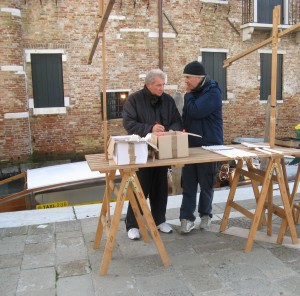Of course you already know that “La Madonna della Salute” does not mean “Our Lady of the Salute.” She is Our Lady of Health, and every year on November 21 everyone in Venice who can walk, and even some who can’t, make the pilgrimage to her church to offer a candle and say however many prayers are filling their hearts.

Yesterday was not a propitious day, meteorologically speaking. For two or three days the Gazzettino had been feverishly predicting acqua alta of 120 cm [four feet] that morning. (It didn’t happen.) There was plenty of water, however, in the form of a frigid rain. It wasn’t heavy, but it was determined, the kind of rain that isn’t thinking about anything else. And it got dark early.

There had also been an anxious sub-theme, which began circulating several days early, on the impending castradina famine. Castradina the basis of the traditional dish for this festival, a soup made of cabbage and a haunch of mutton which has been dried, smoked, aged, slathered in dark malodorous spices, and possibly even beaten with sticks and dead-blow hammers. It’s an impressive little piece of meat.
But this year, the Muslim festival of Eid al-Adha, or Festival of Sacrifice, fell in the same period. Which meant that the general supply of castradina — which has never been huge, seeing as the tradition had fallen into general disuse — had suddenly shrunk to almost nothing. I have now learned that Muslims favor this foodstuff for their religious observance, and that they offered a better price to the few remaining wholesalers who carry it.
This is amusing, in a way (it takes so little to amuse me), because for years many people didn’t care about castradina. We’ve had Venetians over to dinner who had never eaten it. We’d see these hunks of black flesh hanging in the butcher shops and would wonder what they did with the ones they didn’t sell.
But in the past year or two, castradina has come back into fashion. So Venice, according to the Gazzettino, was pullulating with desperate people seeking castradina by any means, in any place, at any price. I can’t think of a credible substitute. You couldn’t fake it even with tofu.

Back to the weather. It was cold, dark, and wet. Just what I think of as perfect weather for this feast, though the women in the mink coats were thwarted by the rain. As you know, they come out in force on this day even in the driving sun. The need to show off their fur is just too strong. If you’re wearing beaver or seal, fine. But minks do not like rain any more than their humans do. I kind of missed seeing these self-contented matrons in their luscious garb. They do love it so. Lino calls this the feast of Our Lady of the Fur Coats.


This year, to my surprise, we got into the church without having to battle a rugby scrum, and we walked right up to the candle-lighting station and handed over our candles. This was an odd but very pleasant sensation. Last year there was such a crush of people that I honestly thought we’d be trapped there holding our candles till Christmas Eve.
Then, as usual, we joined the file of people who elected to walk past the high altar and venerate the little Madonna on the other side, crossing themselves and tossing some cash, and walking out through the sacristy. We found two seats in the heavy wooden choir stalls and sat down to watch people go by. Even though there weren’t massive crowds, the flow was steady. So far, so normal.
You can’t force pious thoughts. If you try, they just slide off your brain. So I sat there not thinking at all, somewhat lulled by the rosary recitation floating over from the other side. And then a thought came to me — more a realization than a thought. I realized that we were being faithful.
All those thousands of frantic, distraught Venetians had been watching people die of the plague all around them till all they had left to offer in exchange for their lives was to promise the Virgin that if she would intercede and save what was left of the city, they would build her a church and come to offer her candles and gratitude every November 21 forever. And after 380 years, people (us) who are so far away from the original promisers that their vow could be thought of as symbolic, or even meaningless, are still maintaining that vow.
Crumpled-up little old people, children of every shape and temper, families of various nationalities, teenage boys, an assortment of tourists — anybody who was there formed another link in the chain tying us to those helpless, despairing people who made a promise that they believed we would keep.
And we did. And we will.


6 Comments
It is interesting that the Venetians were willing to make a second try with the “build a church to keep the plague away” plan, since il Redentore obviously didn’t do the job. I wonder what sort of construction would be needed to end some of the modern plagues, like il moto ondoso, aqua alta (MOSE isn’t it), or mass tourism.
I believe you may have misinterpreted the reasons for these two churches. They weren’t built to “keep the plague away” — they were built as votive offerings in thanksgiving for having been delivered from the particular plague in question. This belief is still extant for concerns up to and including plague: You pray to a saint or whoever for intercession to resolve a particular problem or situation and promise to give a certain gift or token if your prayer is answered. The gift usually isn’t as big as these churches, but the dynamic is the same. If we were to proceed on this line for the modern “plagues” you mention, we would need to pray sincerely and promise a gift if our prayer is answered. You can see how we’d be in more difficulty these days than they were back then, seeing how few people, compared to all those believing Venetians, would be able to undertake such a project.. May I note that acqua alta is not a plague. And if mass tourism, which is a chronic, rather than an acute, disease, were to be “cured,” the city would die. So, you know. It’s always something.
I’m curious whether the shortage of castradina–which is delicious–occasioned by the Muslim feast of Eid al-Adha falling at the same time as the Venetian holiday this year doesn’t suggest the possibility that either the Venetians took over this culinary tradition from the Muslims or the Muslims got it from the Venetians. Since the Muslim holiday commemorates the sacrifice of Issac, with the substitute ram being offered up, the legs of mutton certainly make sense; whereas, the legs of mutton don’t seem to have much of a logical connection to the reprieve from the plague. So, my money would be on the dish being taken over by the Venetians. Sacrilege, I know, but any thoughts?
(By the way, you didn’t mention whether you managed to get some castradina for yourself this year. I hope so.)
It doesn’t appear, from my research, that there is a definitive link between Islam and castradina and Venice. You recall that Venice dominated the Dalmatian coast for centuries, to one extent or another, after the year 1000 A.D. The first written mention of a product that corresponds to castradina was in 1173 (the Ottoman Empire was founded and began to spread after 1299) in which doge Sebastiano Ziani refers to “dried meat from Romania and Schiavonia” (a general geographic area corresponding to much of the Balkans, which supplied Venice with timber and stone, as well as meat, and also slaves. But that’s another story). It appears that Venetians began to eat castradina for the feast of the Salute after the great plague ending in 1630 because the last ship allowed to enter Venice before the city placed itself under quarantine was carrying a cargo of castradina — a product which obviously could withstand months of quarantine and still be comestible. What little I have been able to determine (scholars don’t have much documentation to go on) is that it is essentially a Balkan dish. But there were Christians as well as Muslims in the Balkans, and Christians also eat lamb (especially at Easter). So, obviously, do Jewish people at Passover, though they didn’t eat castradina. Then again, Venetians were trading in the Middle East and for products from far beyond it for centuries also, so it’s probably inevitable that they would pick up some elements of foreign dishes. There are certain Venetian specialties that contain what I consider to be unmistakeable touches of Eastern (don’t know if you could call it Muslim) cuisine. An example at random: pinoli nuts and raisins in sarde in saor. Ultimately, the particular value of castradina appears to have been its being aged and preserved in such a way as to be eatable basically any time it was needed. Muslim demand never made itself felt before this year, so I’d say it’s just a coincidence that the Muslim holiday and the Venetian feast occurred in the same period in 2010. After all, the Salute is always November 21, while Eid al-Adha is a moveable feast, falling on the 10th day of the 12th month of the lunar Muslim year. And yes, we did get our castradina this year — we bought it two weeks in advance. Boy, were we proud of ourselves.
Fascinating history! Thank you for the research. I guess one of the many virtues of castradina is that you can buy it early.
Something else occurred to me about the “grinding need” you mentioned. Let’s say that there is high water 3 times a week (unlikely, but not impossible) every week for 6 months (also unlikely). That comes to 96 high waters a year, or 269 days without high water. The average snowfall for Denver, Colorado (I picked it at random; maybe Jackson Hole would have been better….) is 55.4 inches a year. Let’s say it snows from October to April, that’s 7 months, or 8 inches a month. That’s more than high water amounts to but Denver people prepare for it and keep on going. Snow melts, the tide goes down. With all due respect, and I mean that sincerely, I just can’t find the problem with high water that would qualify as “grinding.”